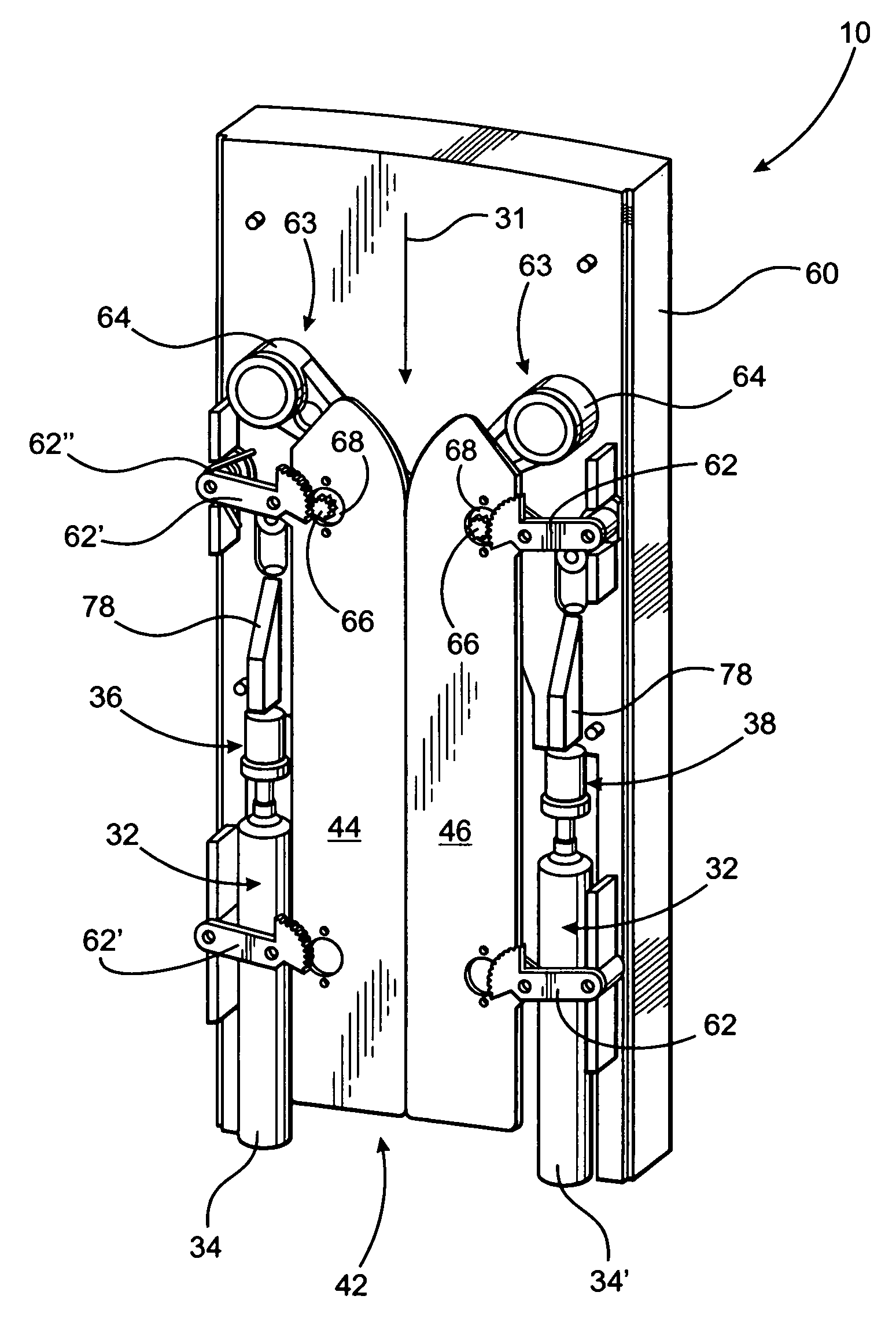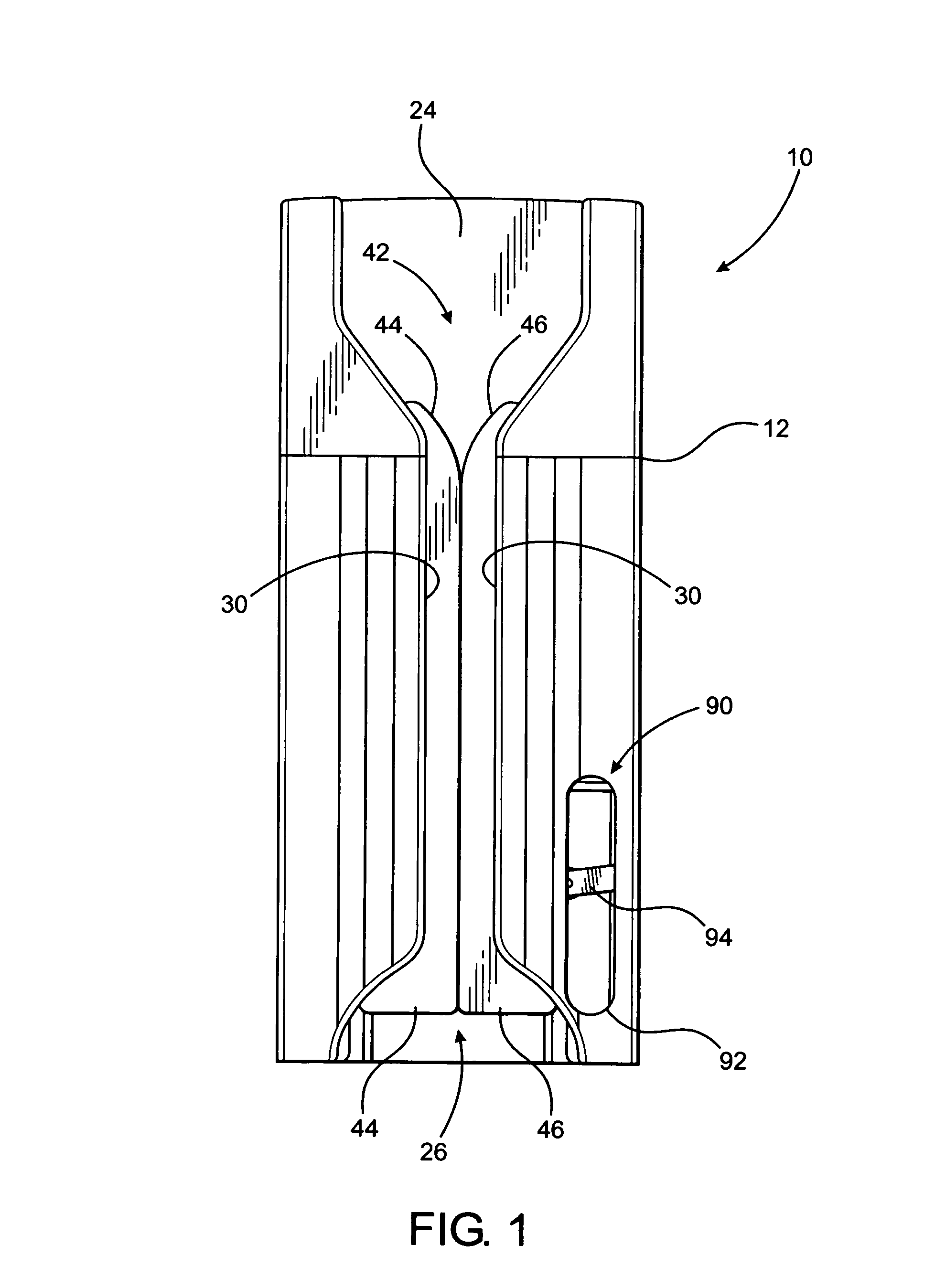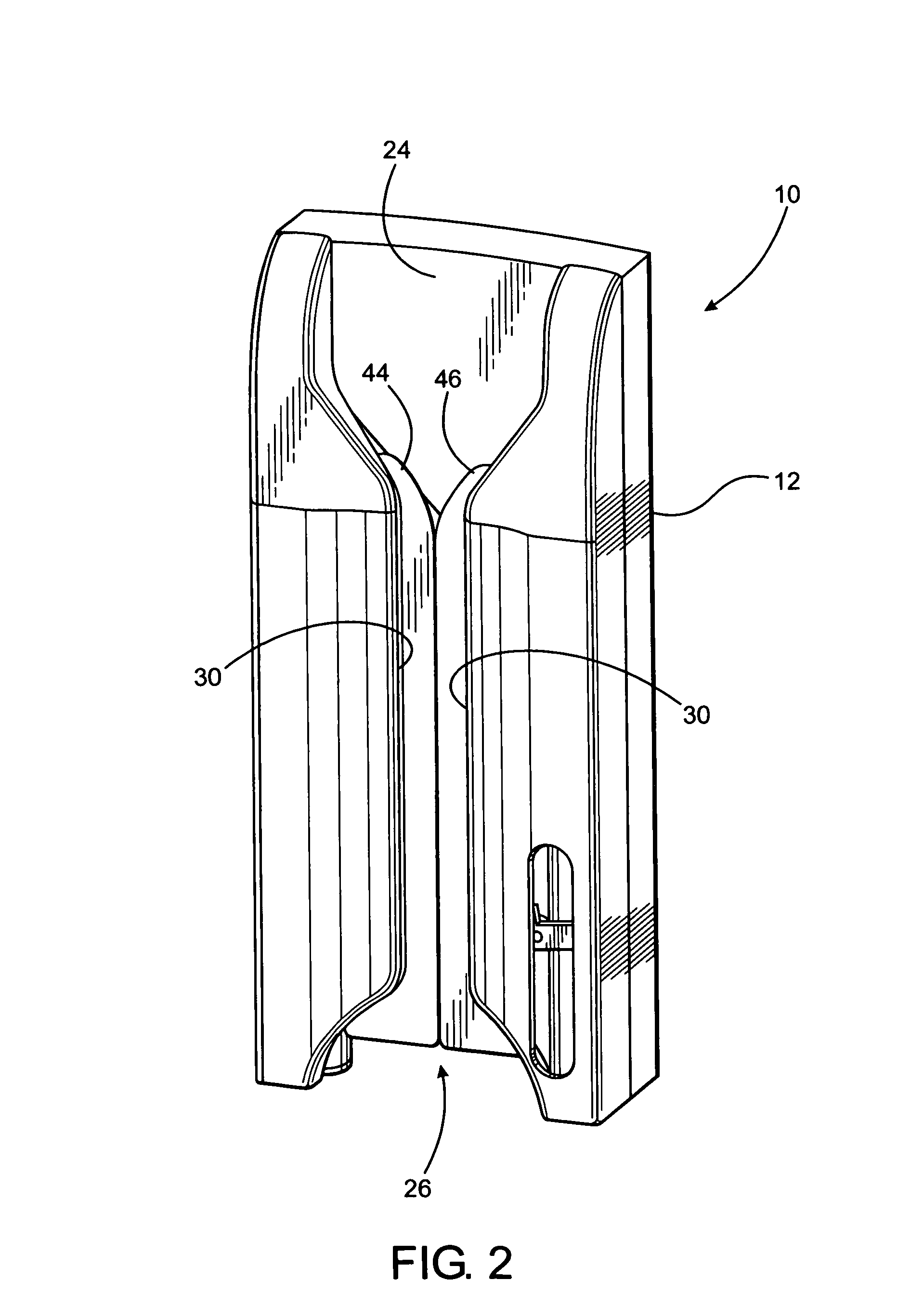[0024]When the head portion is passing along the path of travel, the diaphragm, supporting rim and other contiguous parts of the head portion are segregated from the exterior of the housing and ambient conditions associated therewith. It is further emphasized that in order to increase the efficiency and effectiveness of the cleaning procedure, the housing as well as the path of travel and other components to be described in greater detail hereinafter are selectively structured, disposed and dimensioned so as to facilitate passage of the head along the path of travel and between the entrance and exit portions by means of a single “swiping” action. Such a swiping action eliminates the requirement or need for a successive, reciprocal or repetitive type of movement of the head portion on the interior of the housing and along the path of travel in order to accomplish an effective cleaning thereof as intended.
[0027]In a most preferred embodiment of the present invention the versatility, safety and efficiency of the cleaning assembly is further demonstrated by the elimination of the need for any supplemental power. Supplemental power, in the form of an electrically driven motor, has been employed in other devices with a similar purpose. The use of an electrically driven motor poses to the user the risks of malfunction, fire, electrical shock or explosion. The risk of fire and explosion are even greater when considering that the vast majority of preferred cleaning fluids for equipment cleaning are alcohol based and flammable. Other known cleaning assemblies, while not employing a motor or flammable cleaning fluid, do utilize high voltage electricity (200-1,000 volts), which exposes the user to the risk of electrocution. Also, known devices of this type pose a risk of UV light exposure to the user or others in the vicinity of the device, when in use.
[0029]Moreover, the applicator assembly is disposed and structured to apply cleaning fluid to the diaphragm and other appropriate portions of the head of the stethoscope, which contact the applicator assembly as the head of the stethoscope passes along the path of travel. The applicator assembly is also disposed and structured to provide a cleaning and possibly mildly abrasive action to the head portion as well as remove excess cleaning fluid therefrom. The above set forth cleaning procedure is accomplished on the interior of the housing prior to removal of the head portion through the aforementioned exit. In addition, the applicator assembly, in at least some of the embodiments of the present invention, may be removably mounted on the interior of the housing, as part of a removable, replaceable cartridge, so as to facilitate replacement and / or maintenance thereof when needed.
[0030]Accordingly, the structural and operative features of the cleaning assembly of the present invention allow for the utilization of a single swiping action which is unique and distinguishable from known or conventional stethoscope cleaning assemblies. Moreover, in a single, smooth, one-handed, unidirectional swiping maneuver, the operator brings the stethoscope head into the interior chamber of the housing of the device. In the same swiping maneuver, the operator brings the stethoscope head in contact with the one or more activating members thereby forcibly driving the one or more activating members into an operative position to actively dispense cleaning fluid onto the aforementioned applicator assembly. In the same swiping maneuver, the operator brings the diaphragm and rim portions of the stethoscope head into operative contact with the various components of the applicator assembly. This serves to distribute cleaning fluid across the diaphragm and rim in such a manner as to disinfect the diaphragm and rim. In the same swiping maneuver, the operator brings the diaphragm and rim portions of the stethoscope head into activating contact with a cleaning member of the applicator assembly, which serves to remove dirt, debris and contaminants from the stethoscope diaphragm and rim. In the same swiping maneuver, the operator brings the diaphragm and rim portions of the stethoscope head into activating contact with an additional member of the applicator assembly that serves to remove excess cleaning fluid, thereby at least partially drying the diaphragm and rim. In the same swiping maneuver, the operator brings the stethoscope head further along the path of travel until it exits the interior chamber of the housing. The end result of this single, smooth, one-handed, unidirectional swiping maneuver is a disinfected, cleaned and at least partially dried diaphragm and rim of the stethoscope head.
[0031]Accordingly, the structural and operative features of the stethoscope cleaning assembly of the present invention overcome many if not all of the disadvantages of known or conventional devices. More specifically, such conventional devices typically require the use of two hands, one to hold the stethoscope and the other to depress or push an activating structure on the conventional cleaning devices. Any lever or button located externally to a conventional cleaning device may become infected or contaminated by the external environment. If a user touches an external lever or button with a hand, the user's hand may become infected or contaminated with potentially dangerous microorganisms located on the lever or button. The present invention avoids this potential serious contamination risk by the elimination of any external activating buttons, levers or like members. Yet other conventional or known cleaning assemblies require a separate wiping maneuver to dry the stethoscope head on a pad external to the device. An external pad is less advantageous in that this pad is also susceptible to infection and contamination by the external environment. This infection and contamination may be spread to the user's stethoscope during the drying maneuver. The present invention, which lacks an external pad or like structure avoids this potentially serious contamination risk.
[0032]Therefore, the cleaning assembly of the present invention comprises structural and operative features which facilitate the cleaning, and / or disinfecting of the diaphragm, rim and other appropriate portions of the head of the stethoscope in a quick, effective and reliable manner so as to overcome many of the disadvantages and problems associated with known or conventional cleaning assemblies intended for this purpose.
 Login to View More
Login to View More  Login to View More
Login to View More 


